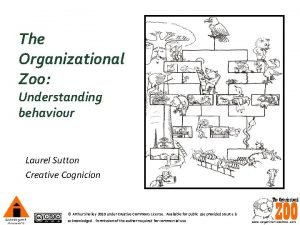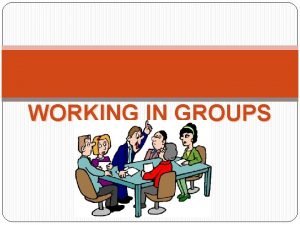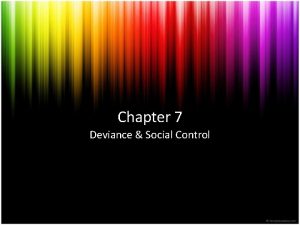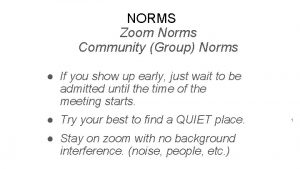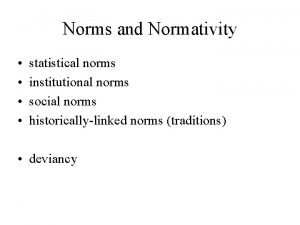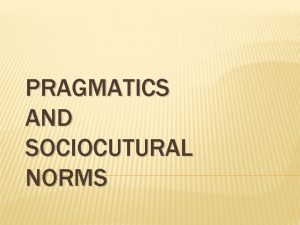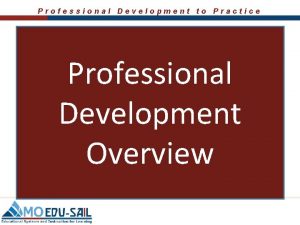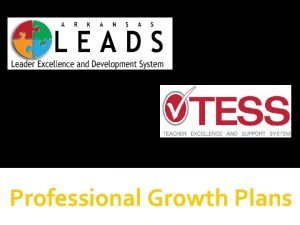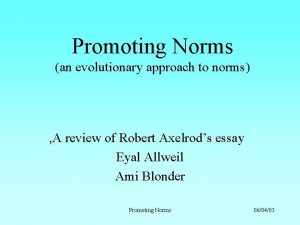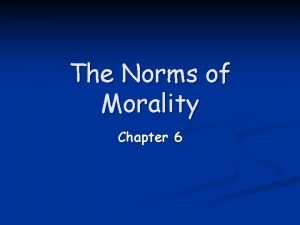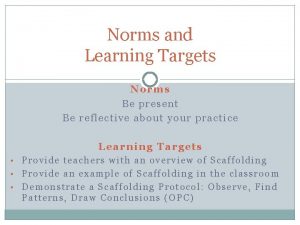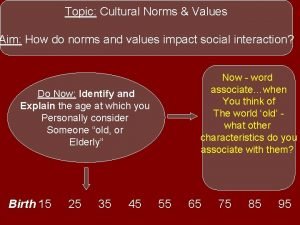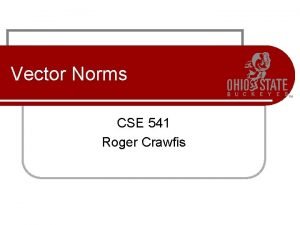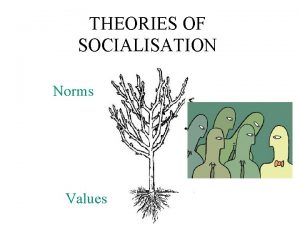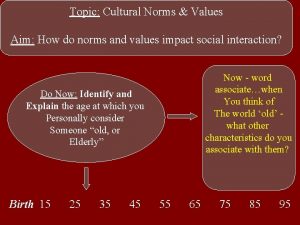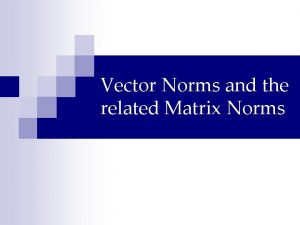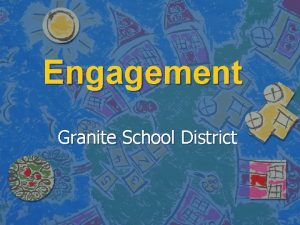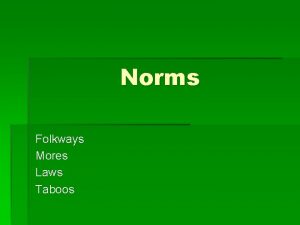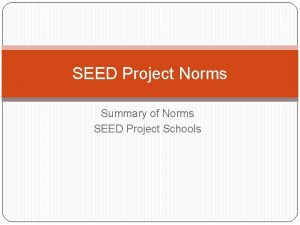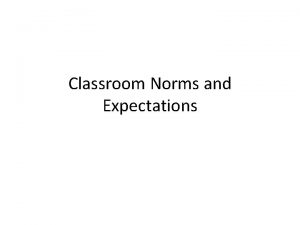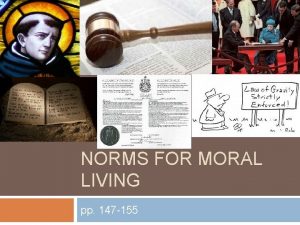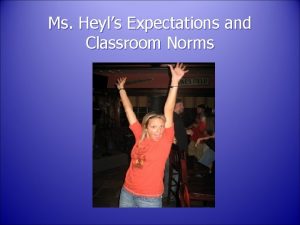Group Norms for Professional Development o o o







































- Slides: 39

Group Norms for Professional Development o o o We will encourage each other to take an active part in discussion We will listen to each other in an effort to examine our own teaching beliefs We will not engage in sidebar conversations or actions that detract from our task to grow professionally We will keep time boundaries regarding beginnings, ending, and breaks We will turn off cell phones, email, and use computers for note-taking only

Agenda o o o Your expectations Faculty meeting review Round Robin Comprehension strategies SAS reminders Wrap up

Your expectations Post it note it- n What do you want out of your professional development today and/or in future days? n Focus – o Content AND process

Interesting statistics-redux o More than eight million adolescents are unable to read at grade level (NCES, 2005). o 94% of American children about to graduate from high school cannot independently read and gain information from specialized text (a. k. a. content area textbooks) (NCES, 2006). o Decades of validated research shows that integrating literacy instruction into content area classes improves academic outcomes for adolescent learners (Cantrell, Burns & Callaway, 2009). http: //www. aabri. com/manuscripts/10519. pdf

So now what? • We would need 575 days in the school year to cover all the content standards in the state of PA… • 3% of instructional time is devoted to helping adolescent readers make sense of text (Ness, 2008)

Round Robin reading o A definition: Round robin reading is a teacher directed strategy where students read one after the other during the first reading of a text o Pros and cons n With the people at your table, list at least 4 pros and 4 cons of Round Robin reading

Round Robin is Still Doing the Rounds - Power Point Slides Handout o Read the information on the slides o Highlight what stands out to you o Use text codes with slides of your choice n n ! = I agree! = I don’t know this word OR I don’t know how to pronounce this word ? = I have a question ** = I didn’t know this

When you finish reading the slides 1. Write a 5 line summary of what you read 2. Go back to the last slide and circle the 3 reasons that are the most convincing reasons to stop using Round Robin Reading

Find a partner 1. Read your summary verbatim to your partner 2. Partner responsibility – listen quietly. Respond with a question or comment 3. Switch roles and repeat the process 4. Then compare your circled reasons from the last slide 1. 2. Do you agree with each other? Discuss

Debrief o Content- n n n o children must process the text themselves repeated readings last slide Process n n n highlighting what stands out text coding verbatim reading to partners

Partner reading o A very effective way to read text n Read the article “Popcorn and Round-Robin Reading: a critique of whole-class, oral reading techniques” aloud to one partner Use voices that are loud enough just for you and your partner to hear Stop at the end of each section Then go back to the section you just read and highlight anything new that you did not already know Continue this process until you finish the article n Text: Popcorn and Round-Robin Reading: a critique of whole-class, oral reading techniques n n

Reflect… o Complete the 4 -3 -2 -1 handout by yourself. o This will not be shared with anyone-this is for your own personal reflection

Debrief o Content n n n o “illusion of covering content” “combat reading” active reading/meaning making concerns Process n n n partner reading technique stop at the end of each section highlighting only new information revisiting text 4 -3 -2 -1 as a reflective tool

Two column note taking o Read the article “Alternatives to Popcorn or Round. Robin Reading” silently to yourself o Complete the two-column notes as you read o When you finish, find a partner o Compare your notes n Make changes as needed Text: Alternatives to Popcorn or Round-Robin Reading

Debrief o Content n n n o differentiate by using multiple texts small group reading -multiple texts v. single text partner reading opportunities independent reading opportunities uses of oral reads when they are not “cold reads” Process n n n format of 2 -column notes scaffolding opportunities – main idea and/or details side extra white spaces

A cautionary tale o 1 minute and 35 seconds of entertainment o http: //www. youtube. com/watch? v=FDe 84 BYxo. E

Comprehension Strategies What effective readers use automatically in order to completely and fully understand difficult text

Inquiry Chart o As you see the slides for comprehension strategies, complete the inquiry chart o Ahas!/Validations Teaching ideas Questions you have Barriers/potential pitfalls o o o

Why teach strategies? o Reading is a process of thinking o Readers must be taught the process of thinking o One way to teach that process is to show strategic ways to derive meaning from text

The 3 kinds of reading strategies o BEFORE- Things a reader does before actually reading the text o DURING- Things a reader does while reading the text o AFTER- Things a reader does when finished reading the text o They are all forms of ACTIVE READING

BEFORE READING… Previewing o From the text, find out the following: o What chapter is this text from? What is the title of the chapter? How many headings are there? What color font are the headings written in? What are the titles of the two headings? o o

BACKGROUND KNOWLEDGE o o This could be the MOST overlooked strategy It’s what a reader already KNOWS about the topic. Effective readers take the time to collect their thoughts on the topic they are reading before they start to read the text. This is a BEFORE reading strategy

MAKING CONNECTIONS o Connections help readers relate what is read or is about to be read to something they already know. o Connections can be based on: n n something in the reader’s own life (TEXT-TO-SELF) or something they’ve read or seen in the movies (TEXTTO-TEXT) n or something that happened in the world (TEXT-TOWORLD) o This is a usually BEFORE reading strategy but can be a DURING reading strategy too!

QUESTIONING o Effective readers ask questions all the time to: n n o find out more information make things clearer (clarity) understand more deeply figure out what you don’t know This is a BEFORE, DURING, and AFTER reading strategy

INFERRING or Making Inferences o Readers make inferences when they can figure out hidden messages in the text even though it doesn’t exactly say it o It is reading between the lines but it is MORE than a prediction. Inferences should be accurate in order to improve understanding o Inferring provides the basis for strong comprehension o This is a DURING reading strategy

VISUALIZING o Effective readers create a picture or movie in their minds when they read text o Having these pictures help readers “see” the text which is proven to help comprehension o This is a DURING reading strategy

DETERMINING IMPORTANCE o An effective reader is able to figure out what details are the MOST important, those that are somewhat important, and those that are the LEAST important. o This is the KEY to understanding the main idea o This is often the most difficult strategy to master o This is a DURING reading strategy

How to do it o Look for KEYWORDS. Keywords are words that are said more than once in a paragraph (excluding “the, a, it, ” etc. ) o Highlight or write the keywords down. Try to make a logical sentence using all the keywords. o This logical sentence you made from the keywords will most likely contain the most important information from that paragraph

Self-monitoring/ Fix up strategies o o Effective readers realize when they no longer understand what they’re reading. Fix up strategies are used by effective readers to help them when they stop understanding the text. Many effective readers do this automaticallywithout even realizing that they are using a fix up strategy. This is a DURING reading strategy

List of Fix up strategies o Stopping and going back to clarify thinking (Reader says, “Wait. I think that just said “xyz. ” Am I right about what I think? Let me check. ) o Rereading to understand more or better (Reader says, “Wait. I’m going to read that over. The first time didn’t make sense. ) o Reading ahead to clarify meaning (Reader says, “That didn’t make much sense. Let me see if this next sentence helps me understand the last one. )

Still more! o Questioning what the author thinks or is saying (Reader says, “So, what is the author really saying here? Does the author really think this way? ) o Disagreeing with the author o Talking to another reader about what they understand (If you both think the same things, then your (Reader says, “I don’t think the author is right here. Let me see if I have all the facts straight). understanding is accurate. If not, somebody might have misunderstood the text).

And more! o Sounding out the unknown words (effective readers do NOT skip unknown words. Find out how to pronounce them AND what they mean by consulting another person or listening to the word on dictionary. com, etc) o Reading the text out loud (When you read out loud, you use another sense [hearing]. Research shows that the more senses you use, the better your comprehension) o Going slow or slowing down (Very effective strategy. Not all text is meant to be read at the same rate of speed)

SUMMARIZING o Effective readers take the time to think about the most important details and retell what they just read in summary form. o Summaries should contain the 5 Ws and 1 H (who, what, where, when, why and/or how) o KEYWORDS can be used in a summary as well! o This can be done after: n every sentence (if the text is particularly dense and difficult); n every paragraph (this is when it usually happens); n every page; n or at the end of a piece of text that is easily understood by the reader. o This is an AFTER reading strategy

SYNTHESIZING o Effective readers synthesize when they have new, different, or changed thinking based on what they just read. o Effective readers develop their own ideas and thoughts about the text after they take all those thoughts, mix them together, “bake” them in their brain, and develop their own ideas. o An effective reader might say…“At first I thought, but NOW I think…” or “My thoughts are changed now that I read. Here’s how…” o This is an AFTER reading strategy

Debrief o Content n n n o BDA ideas effective readers automatically use many of these explicit teaching – using the reading vocabulary Process n n choose which slides to respond to variety of emotions to consider

Standards Aligned System http: //www. pdesas. org o Materials & Resources n n o Keyword- reading Grade level – 10 th Flip book creator Comic book creator Karpeles documents n n n Materials and resources Keyword – Karpeles Scroll down – interactive document

Standards Aligned System-Part II http: //www. pdesas. org o Fair assessments – n o Assessment creator Materials & Resources n n Keyword – Thinkfinity Keystone icon means PA educator content

Break the habit! Teachers are most likely to use or teach reading strategies that require the least engagement and preparation from them (Alger, 2009)

Thank you! o Resources: n n n www. suite 101. com www. pdesas. org www. aabri. com/manuscripts/10519. pdf www. reading. org/. . . /Round_Robin_Reading_is_Still_Doi ng_the_Rounds. pptx Strategies that Work by Stephanie Harvey and Anne Goudvis
 Norms for professional development
Norms for professional development Norms for professional development
Norms for professional development Laurel sutton
Laurel sutton Informal group norms
Informal group norms Examples of deviance
Examples of deviance Kontinuitetshantering i praktiken
Kontinuitetshantering i praktiken Typiska drag för en novell
Typiska drag för en novell Tack för att ni lyssnade bild
Tack för att ni lyssnade bild Vad står k.r.å.k.a.n för
Vad står k.r.å.k.a.n för Varför kallas perioden 1918-1939 för mellankrigstiden?
Varför kallas perioden 1918-1939 för mellankrigstiden? En lathund för arbete med kontinuitetshantering
En lathund för arbete med kontinuitetshantering Kassaregister ideell förening
Kassaregister ideell förening Tidbok
Tidbok Sura för anatom
Sura för anatom Förklara densitet för barn
Förklara densitet för barn Datorkunskap för nybörjare
Datorkunskap för nybörjare Stig kerman
Stig kerman Hur skriver man en tes
Hur skriver man en tes Magnetsjukhus
Magnetsjukhus Nyckelkompetenser för livslångt lärande
Nyckelkompetenser för livslångt lärande Påbyggnader för flakfordon
Påbyggnader för flakfordon Arkimedes princip formel
Arkimedes princip formel Svenskt ramverk för digital samverkan
Svenskt ramverk för digital samverkan Kyssande vind
Kyssande vind Presentera för publik crossboss
Presentera för publik crossboss Vad är ett minoritetsspråk
Vad är ett minoritetsspråk Kanaans land
Kanaans land Treserva lathund
Treserva lathund Mjälthilus
Mjälthilus Claes martinsson
Claes martinsson Cks
Cks Verifikationsplan
Verifikationsplan Mat för idrottare
Mat för idrottare Verktyg för automatisering av utbetalningar
Verktyg för automatisering av utbetalningar Rutin för avvikelsehantering
Rutin för avvikelsehantering Smärtskolan kunskap för livet
Smärtskolan kunskap för livet Ministerstyre för och nackdelar
Ministerstyre för och nackdelar Tack för att ni har lyssnat
Tack för att ni har lyssnat Hur ser ett referat ut
Hur ser ett referat ut Redogör för vad psykologi är
Redogör för vad psykologi är


